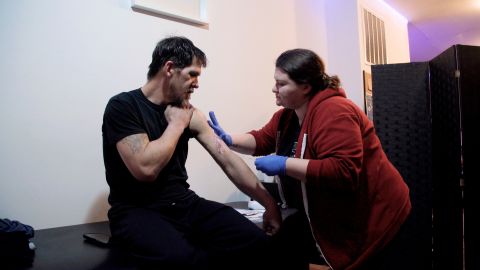Tranq has become a bigger part of Philly’s street fentanyl supply. The wounds left behind are killing people
Philadelphia (CNN) — What drug users and people who work with them in Philadelphia talk about is the smell. The smell of rotting flesh from open infected wounds.
Some users say they feel ashamed of the state of their bodies, but more feel a sense of urgency. They need help. The wounds are killing them.
“It is absolutely horrible. That’s the reality, though,” said James Sherman, known as Sherm around Philadelphia’s Kensington neighborhood, where he once used drugs and where he now tries to help those still on the streets.

The need for help has become more urgent over the last three years, as the animal tranquilizer xylazine, also called tranq, has become a bigger part of Philly’s street fentanyl supply. Xylazine can cause large wounds that won’t heal, no matter where you inject it and they can appear even if you snort it or smoke it. Infections are common and can even lead to amputations.
“Some people aren’t ready to see that yet,” Sherman said. “It’s literally people’s flesh rotting, and you can smell it.”
Kensington has seen the changing nature of America’s addiction crisis. It has been well known as a place to buy heroin under the elevated rail line, a short distance but a world away from the business and tourist centers of downtown.
Heroin was edged out by the more powerful synthetic opioid fentanyl. But fentanyl’s effects don’t last as long as heroin, and so xylazine was added to street fentanyl to “give it legs,” according to Sarah Laurel, who founded Savage Sisters, the harm-reduction group that employs Sherman.
Xylazine is not approved for humans, but it’s widely available for veterinarians to sedate large animals like horses. Like an opioid, it can kill pain but it cannot be reversed with Narcan, also known as naloxone, which is used to treat opioid overdoses, according to the US Drug Enforcement Agency. As xylazine is usually mixed in with fentanyl, naloxone can help an overdosed person by counteracting the opioid, though other measures may be needed. Workers at Savage Sisters now carry oxygen tanks with them.
The drug has side effects like “tranq walk,” where people seem unaware of their surroundings, along with sores and wounds.
A user, Maggie, told CNN what she’s seen. “You shoot up and you miss, you get a sore. You don’t take care of your sore, you’ll wind up in a hospital with a hole,” she said. It had happened to her. It started out like a pimple, and then it got bigger, and then the skin came off and she had a half-dollar-sized wound. “I could have lost my hand.”
Tranq made its mark on Philadelphia’s street drugs about three years ago. That’s when doctors, users and those who try to help them saw a difference.
Dr. Joseph D’Orazio, an emergency physician and addiction medicine specialist at Temple University Hospital, said patients started to have major wounds that were different from typical injection drug use. “These wounds were a lot deeper, a lot more severe, there were big necrotic areas,” he said. “They were deep down into tendons. Sometimes you can see the bones, and we were starting to see more patients that were requiring amputations.”
Continue reading the full article on CNN.
